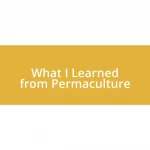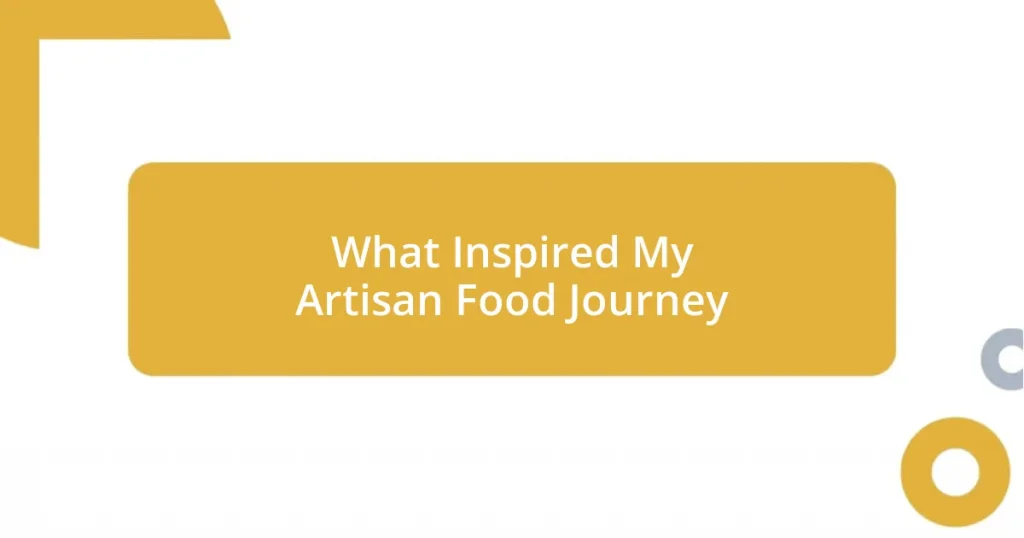Key takeaways:
- The journey into artisan food fosters a deep connection to community, tradition, and the artisans behind the products.
- Experiences from family cooking, culinary classes, and travels significantly shape one’s culinary perspective and appreciation for authentic flavors.
- Discovering local ingredients and learning traditional techniques enhances the cooking experience, emphasizing the importance of seasonal and culturally rich practices.
- Community support and mentorship play crucial roles in fostering creativity and confidence in the culinary journey.

Introduction to Artisan Food Journey
Artisan food is more than just a trend; it’s a heartfelt journey that connects us to our roots, traditions, and the people who create it. I remember the first time I walked into a quaint market, drawn in by the heady aroma of freshly baked bread and the vibrant colors of local produce. Isn’t there something magical about experiencing food crafted with passion and skill?
As I delved deeper into this world, I found myself reflecting on what truly defines artisan food. It’s that exquisite attention to detail and the story behind each product that captivates me. Have you ever pondered why a simple jar of jam can evoke such warmth? For me, it’s the knowledge that someone lovingly nurtured those fruits, transformed them, and sealed a piece of their joy within that jar.
With every tasting, I feel a sense of connection, not just with the flavors but with the artisans themselves. I recall a chat with a local cheesemaker who passionately described her craft, sharing how each cheese echoes the land it comes from. How can one not feel inspired by the authenticity and creativity poured into every bite? This exploration has transformed my relationship with food, revealing it to be a canvas of culture and shared experiences.

My Early Culinary Influences
My family gatherings were a culinary playground. I still remember those summer afternoons at my grandmother’s house, where her kitchen was alive with laughter and the rich scents of her homemade sauces simmering on the stove. The way she transformed simple ingredients into unforgettable meals left a lasting impression on me. I can almost taste the tangy marinara that enveloped every dish; it sparked my love for cooking, connecting food to love and community.
As I grew older, my taste buds began wandering, thanks to a high school culinary class that opened up new worlds of flavor. I vividly recall learning to knead dough for the first time. The tactile experience of working with my hands was transformative—it was as if I was uncovering a hidden part of myself. This moment cemented my desire to dive deeper into the culinary arts, making me realize how transformative food can be.
Moreover, my travels further enhanced my culinary perspective. On a trip to Italy, I tasted an authentic Neapolitan pizza straight from a stone oven, and it was nothing like the frozen versions I had at home. The simplicity of a few quality ingredients flawlessly combined made me appreciate the essence of artisan food even more. Each culinary encounter has been a piece of a larger puzzle in my journey, shaping my beliefs and passions around food.
| Culinary Influence | Key Features |
|---|---|
| Grandmother’s Cooking | Women-led tradition, love-infused meals, communal experiences |
| Culinary Class | Hands-on learning, ingredient exploration, newfound passion |
| Travel Experiences | Authentic flavors, cultural appreciation, transformative encounters |

Discovering Local Ingredients
There’s something genuinely thrilling about discovering local ingredients. A few years back, while wandering through a bustling farmer’s market, I stumbled upon a stand overflowing with heirloom tomatoes. Their vibrant colors caught my eye, and I struck up a conversation with the farmer. He shared how he nurtured those plants with care, and I felt that connection to the earth and the people behind my food. This moment sparked a realization—locally sourced ingredients don’t just enhance flavor; they bring stories and passion to my dishes.
When I think about local ingredients, I can immediately recall the delicious charcuterie board I made using a selection of local cheeses and meats. The pairing created a symphony of flavors and textures that felt truly extraordinary. Here are a few insights I gathered along my journey:
- Fresher Flavors: Local ingredients often burst with flavor, making a noticeable difference in taste.
- Support for the Community: Purchasing from local artisans helps to sustain their livelihoods and fosters community connections.
- Seasonal Awareness: Embracing local ingredients encourages me to cook with the seasons, resulting in dishes that celebrate freshness.
- Unique Discoveries: Each market visit unveils new and unusual items, inspiring creativity in my cooking.
- Environmental Impact: Sourcing locally reduces transportation emissions, making it a more sustainable choice.
Every time I incorporate these fresh, local ingredients into my cooking, I feel a sense of pride and gratitude, knowing I’m part of a rich tapestry of tradition and passion. It’s incredible how food from right down the road can encompass not just taste, but also love and community spirit.

Learning Traditional Techniques
Learning traditional techniques has been a cornerstone of my culinary journey. I recall the first time I watched a local artisan make handmade pasta. The way she skillfully rolled and cut the dough by hand was mesmerizing. It made me wonder, how many generations have passed down this artistry? That sense of connection to history inspired me to replicate her techniques in my own kitchen.
Each traditional method I learned felt like uncovering a hidden treasure. For instance, I took a fermentation workshop where I learned to craft my own kimchi. The process was simple yet profound, transforming humble vegetables into a vibrant, tangy condiment. I found myself thinking about the science behind fermentation—how natural bacteria create rich flavors—and that sparked a desire to deepen my understanding of food preservation techniques. That’s when I realized that these methods aren’t just recipes; they’re cultural legacies.
I also experimented with foraging after attending a workshop on wild herbs. Armed with a basket and a passion for exploration, I wandered through the woods, pulling up nettles and dandelions. It was thrilling to connect with nature like that and consider how our ancestors relied on these same plants for sustenance. Each step became a lesson in respect for our culinary roots and the importance of learning from the land. Traditional techniques are more than just skills; they’re a bridge to a colorful and rich culinary past.

The Role of Community Support
When I reflect on my artisan food journey, I can’t help but think about the camaraderie I’ve found within my community. Joining local food events brought together passionate creators who share the same enthusiasm for quality ingredients. I remember chatting with a fellow artisan about our favorite spices, and it felt like we were both on the same quest to elevate our culinary crafts. This kind of support is invaluable; it thrives on mutual encouragement, fostering a vibrant network that pushes everyone to excel.
Community support also plays a significant role during those inevitable moments of self-doubt. The first time I served my food at a local festival, butterflies danced in my stomach. Surrounded by familiar faces, I noticed how genuine their smiles were when they tasted my creation. That connection—seeing others enjoy my food—filled me with a sense of purpose and belonging that I can’t quite describe. It’s the camaraderie of shared experience that inspires me to keep creating and experimenting.
Establishing mentorship relationships within my community has been a game changer. I remember reaching out to a seasoned chef whose work I admired. After a coffee chat, I came away not only with valuable insights but a renewed sense of direction. When you embrace community support, it’s like gaining a safety net that softens the leap into uncharted culinary territories. It’s essential to remember that we’re not alone in this journey; we can lift each other up, sharing knowledge and inspiration every step of the way.

Creating Unique Recipes
Creating unique recipes has been a delightful challenge for me. I remember tinkering with flavors after a friend encouraged me to host a potluck dinner. I found inspiration in combining unexpected ingredients, like pairing sweet mango with spicy jalapeño. The curious looks on my guests’ faces as they took that first bite were priceless! There’s something incredibly rewarding about watching people discover new tastes, and it made me think, how often do we shy away from bold combinations in our own kitchens?
Experimentation has become my secret ingredient. Each time I step into my kitchen, I view it as a canvas where I can blend flavors and techniques from different cultures. After a trip to a Thai market, I decided to infuse traditional Italian risotto with lemongrass and coconut milk. The result was a creamy, fragrant dish that surprised even myself. It taught me that creative breakthroughs often come from embracing the unfamiliar—are we not all artists at heart, shaping our plates like masterpieces?
Over time, I’ve come to realize that mistakes can lead to delightful surprises. I once accidentally overcooked a batch of roasted beets, but instead of tossing them, I pureed them into a vibrant sauce. That mistake became a staple in my recipe book! It sparked the thought that our culinary journeys are filled with opportunities to innovate. So, why not embrace those kitchen mishaps and transform them into something beautiful? The journey of creating unique recipes is like unwrapping a gift—filled with unexpected discoveries waiting to be savored.















